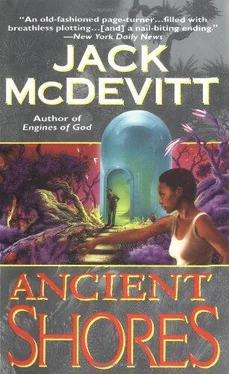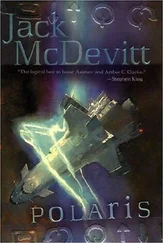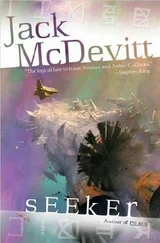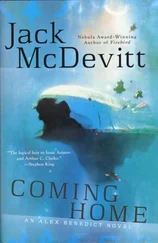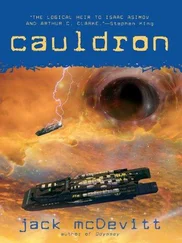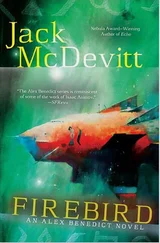Walking back, he saw a teenager wearing a shirt depicting the Roundhouse. The legend read FORT MOXIE, ND—OUT OF THIS WORLD . The Lock ‘n’ Bolt had put together a display of Roundhouse glasses, dishes, models, towels, notebook binders, and salt and pepper shakers. Across Bannister Street, Mike’s Supermarket featured more of the same.
Two school buses were moving leisurely toward him. Bright banners fluttered from both, displaying a picture of the Roundhouse. Across the nose of the leading vehicle, someone had stenciled Misty Spirit . They were filled with young people, mostly college age or a little older, and they waved at him as they went by.
Max waved back, hurried along the street (for he was by now cold), and let himself into his motel room. The sudden rush of warm air drained his energy, and he dropped his coat over a chair and sank onto the bed.
The buses stopped at Clint’s. The restaurant was already too full to accommodate an additional sixty hungry people, but Clint was not one to miss an opportunity. He offered to make up sandwiches and coffee to go, and he accepted reservations for the evening meal. When they had left, Clint noted that his stores of lunch meats, pickles, and potato salad were moving more quickly than he’d anticipated. He dispatched his son to Grand Forks with an order for replenishments.
At the Lock ‘n’ Bolt, Arnold Whitaker was watching automotive supplies jump off his shelves. Also moving very quickly were games for kids to play while traveling and, ominously, firearms. And binoculars. Sales of Roundhouse merchandise were going through the roof. He’d picked the stuff up on consignment, what he thought was a generous supply, but it would be gone by tomorrow afternoon.
When he called for more, his Winnipeg supplier put him on back order.
The Northstar Motel was completely full for the second consecutive week. During its entire history, that had never happened before. At about the same time that Max was falling asleep in his room, management was contemplating doubling the rates.
The price of a drink at the Prairie Schooner had, for some, already risen measurably. The proprietor, Mark Hanford, was careful to install separate rates for regulars and visitors. Ordinarily Mark would have considered such a practice unethical. But these were extraordinary times. A businessman had to adjust to changing conditions. He didn’t expect that anyone would notice, and nobody did.
Mark had also decided to propose that the town council award Tom Lasker a certificate of appreciation. He knew that the motion would ride right through.
Charlotte Anderson, seated in the front of the lead bus, could feel the lines of force. They filled her, washed through the emptiness, and carried her to a level of awareness higher than she had ever known. The grinding of gears in the stop-and-go traffic subsided, and she knew only the triumph of drawing close to a primal destination.
The power source was to the southwest, achingly near. Years ago she had approached such a point in Alaska, near Barrow. It too had put her at one with the cosmos, had established a link between her inner being and the greater universe outside, had tied her to the great web of existence. That too had been a time of exhilaration. But that source, whatever it was, had been buried in a mountain pass beneath glaciers.
Charlotte was trim, honey-blond, clean-cut. There was a kind of forced cheeriness in her manner, an exuberance that seemed reflexive rather than spontaneous. She was from Long Island, had graduated magna cum laude from Princeton, and now possessed a master’s with a specialization in modern European history. She’d been reared Catholic, but during high school Charlotte had become uncomfortable with a faith that seemed to lay everything out so neatly. God the score-keeper. At graduation she’d announced that she had become a Unitarian. Creation is beyond logic or explanation, she’d told her dismayed father; one can only sit back and await the wind that blows between the stars. Her father had assured her mother that everything would be all right, that it was all nonsense and Charlotte would get over it.
Some of the boys with the group, she knew, were more interested in her than in centers of power, but that wasn’t necessarily a bad thing. Given time, they would come around, and that was enough.
The buses had come from Minneapolis, where Charlotte was a manager at a McDonald’s, having left home to find her true self. When the boat had turned up on the North Dakota farm, she’d known it was pointing toward something more. And so had Curie Miller in Madison. They’d talked about it online, the Manhattan group, and Curie and her people, and Sammy Rothstein in Boise, and the Bennetts in Jacksonville, and their other friends around the country, in Philly and Seattle and Sacramento. When the situation had ripened, more than sixty members of the network, wanting to be on hand, had flown into Grand Forks, where Charlotte and a few people from the Twin Cities area had met them with the buses. They’d rented the Fort Moxie city hall and had spent two nights there waiting for stragglers. Now they were ready. And their timing had been perfect: The latest news accounts out of Johnson’s Ridge had fired their enthusiasm (if indeed it had needed firing), and she knew, as they all did, that pure magic lay ahead.
April wasn’t sure which member of Max’s restoration crew had first noticed the series of images in the wall at the rear of the dome. Several claimed credit for finding the icons; but she was struck by the fact that battalions of journalists and physicists, mathematicians and congressmen had marched innocently past the figures. She herself had never noticed them.
There were six, embedded within the glassy surface. They were unobtrusive, black rather than white, and consequently easy to miss in the dark green wall.
The workers had retreated from the area, leaving wheelbarrows and shovels. April stood on a couple of inches of dirt, studying the icons. They were arranged in two columns, each about the size of her palm. Several were pictographic: a tree, a curling line that looked like smoke, an egg, and an arrow. There was also a pair of interlocking rings, and a figure that vaguely resembled a G clef.
They appeared to be three-dimensional, and they were all executed in the representational style of the stag. April peered closely at the tree, the top left-hand figure. Like the others, it was located just beneath the surface. She took out a handkerchief and wiped the wall, trying to see more clearly.
And the tree lit up.
She jumped.
Like neon, it burned with a soft amber glow.
She held her hand against the wall but felt no localized heat.
Nothing seemed to be happening anywhere. No doors opened. There were no changes in the texture of the light. She touched the icon again to see if the light would go out.
It continued to burn.
And a bright golden aura ignited a few feet in front of her. It expanded and stars glowed within its radiance. She tried to call out, but her voice stuck in her throat.
Then, as quickly as it had come, it faded. And snapped off.
There had not been a sound.
April stood, not moving, for a full minute. Where the light had been, a clean circle of floor glittered in the filtered sunshine.
Charlotte inspected the cartons at the back of the bus. One had worked loose and was threatening to fall into the aisle. She reached for it, but Jim Fredrik, from Mobile, got there first and secured it. She thanked him and went back to her seat.
They were behind schedule. The buses had been stalled in heavy traffic about nine miles northeast of the excavation for almost two hours. Signs posted along the route warned them that the site would be closed at six. They were not going to make it.
Читать дальше
